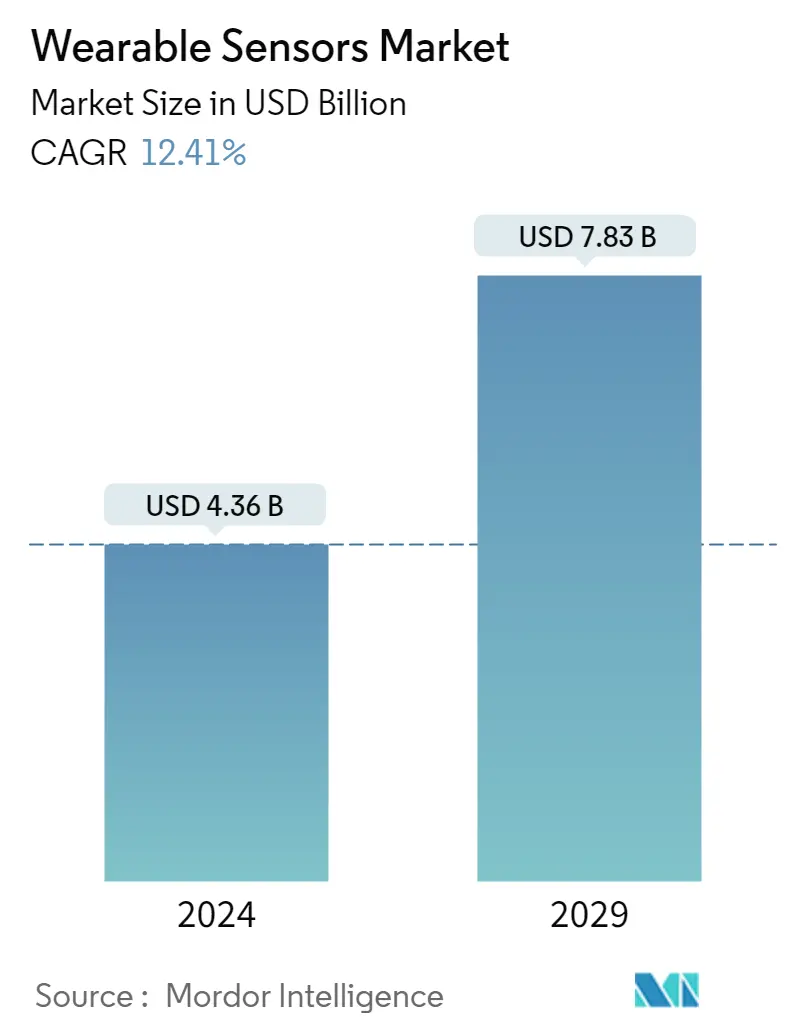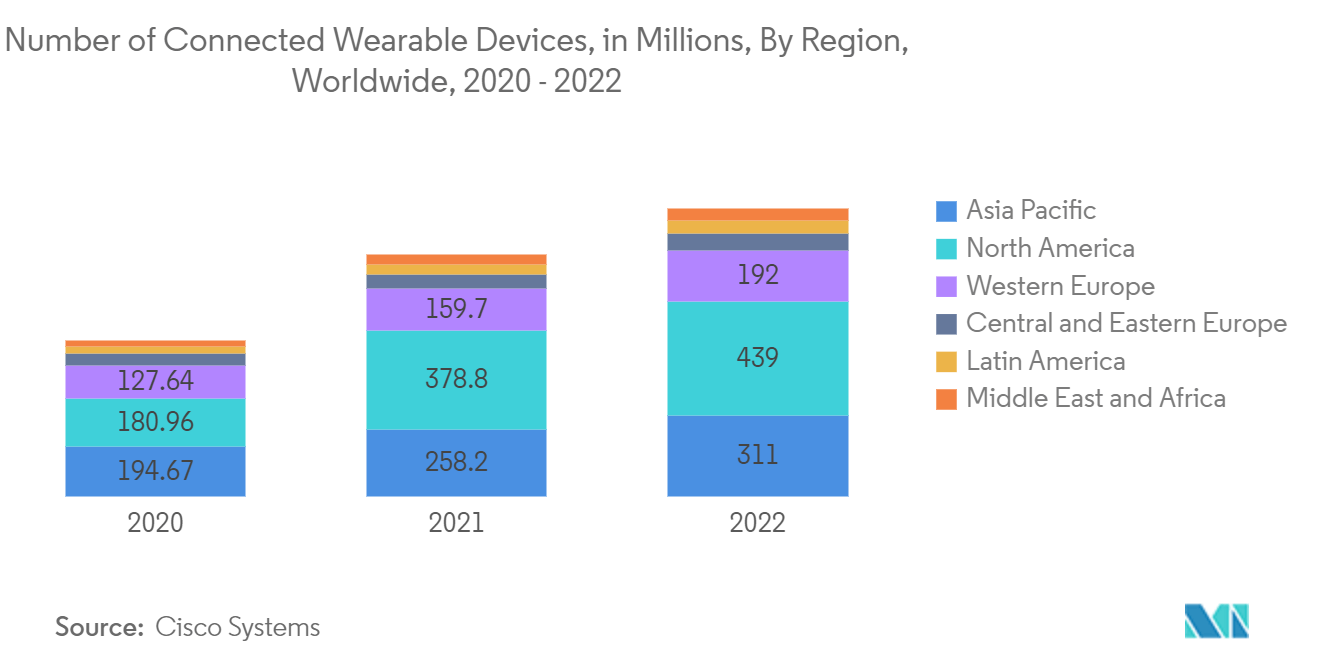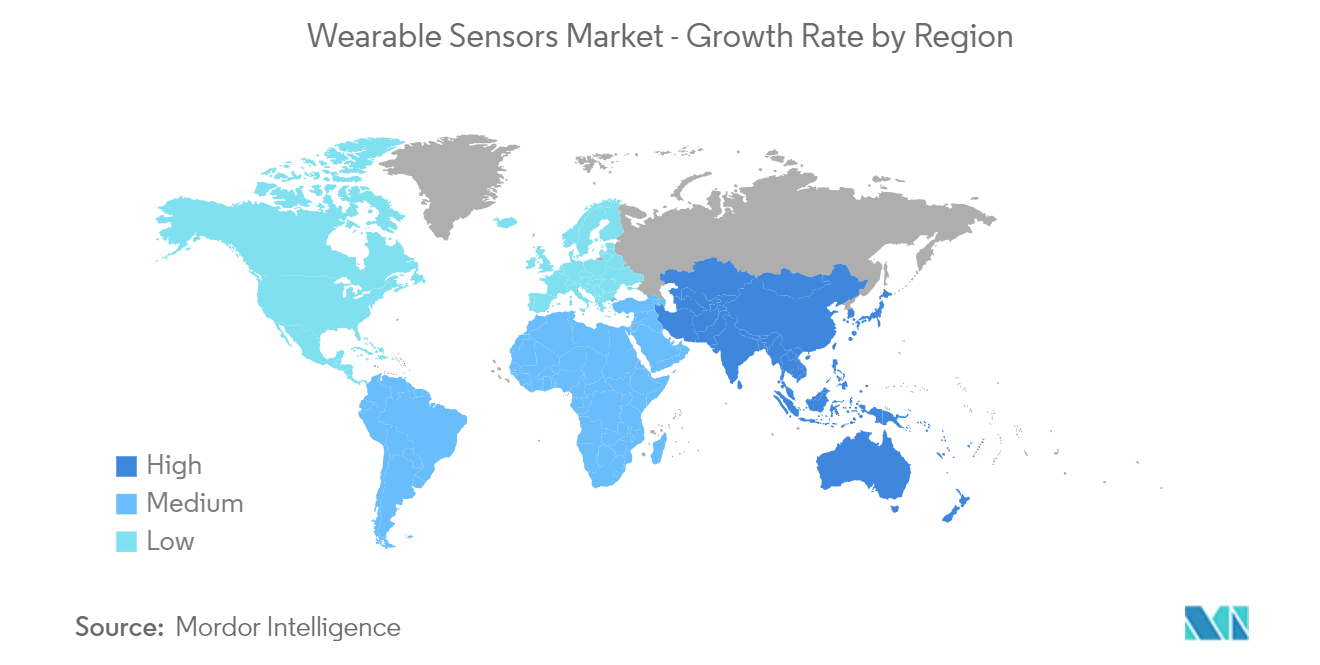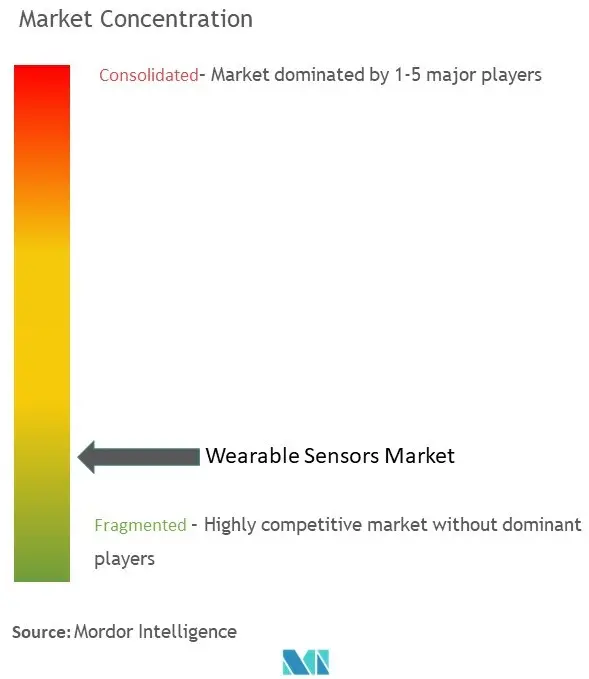Wearable Sensors Market Size

| Study Period | 2019 - 2029 |
| Market Size (2024) | USD 4.36 Billion |
| Market Size (2029) | USD 7.83 Billion |
| CAGR (2024 - 2029) | 12.41 % |
| Fastest Growing Market | Asia Pacific |
| Largest Market | Asia-Pacific |
Major Players
*Disclaimer: Major Players sorted in no particular order |
Wearable Sensors Market Analysis
The Wearable Sensors Market size is estimated at USD 4.36 billion in 2024, and is expected to reach USD 7.83 billion by 2029, growing at a CAGR of 12.41% during the forecast period (2024-2029).
The electronics industry has thrived significantly, primarily due to digitalization, which drives the demand for wearable technology devices widely used for self-health monitoring applications.
- Wearable sensors are crucial to wearable devices due to consumers' growing interest in tracking real-time motion-sensing activities, such as step counting and walking distance covered. Users can define their goals for fitness and health using the specific results provided by analyzing the generated data. Wearable technology completely relies on sensors to monitor consumers' health and data and helps make meaningful decisions. With evolving sensor technology, wearables are becoming smart and gaining popularity among consumers.
- Spending on consumer electronic products is also stimulating the growth of wearable devices. Further, the growing population's increasing urbanization and changing lifestyle have raised its health and safety awareness. This has been the major factor stimulating the growth of wearable devices, such as fitness trackers, ear wears, and smartwatches.
- With the ongoing miniaturization of sensors and related components, the growth of the advanced function sensors in smart wearables, the improvement in the battery sizes, and efficiency are the key drivers boosting the wearable motion sensors market.
- With consumers' growing propensity toward smart wearables, the prices of devices are also soaring along with the growing cost of components, thus limiting adoption in the market. Smartwatches and fitness trackers have low-cost segments that drive significant attention from consumers. However, with the proliferation of technology, other devices such as footwear, eyewear, and body wear products are highly priced and have lower adoption rates. Most wearable technologies are currently highly-priced, which is negatively impacting adoption in the market.
- The COVID-19 pandemic had a favorable effect on the market for wearable sensors and highlighted the necessity of utilizing digital infrastructure for remote patient monitoring. Wearable sensors could help with disease detection and tracking individual and population health since current viral tests and vaccines take a while to develop.
Wearable Sensors Market Trends
Sports and Fitness Segment to Hold Major Market Share
- The increasing demand for wellness monitors and fitness trackers is a crucial factor driving the growth of shipments of wearable sensors globally. Globally, demand for sensor-based devices is increasing as consumers become more aware of the features that these devices provide, such as remote monitoring of wellness and fitness. According to Cisco Systems, North America had the most 5G connections made using wearable devices in 2022. Together, wearables in North America and Asia accounted for around 70% of the wearable 5G connections worldwide in 2022.
- Wearable performance devices are significantly available to the general population and athletic teams. Advancements in technology have allowed individual endurance athletes, sports teams, and physicians to monitor functional movements, workloads, and biometric markers to increase performance. The increased growth is driving the market.
- Technology organizations are making significant strides in growing and advertising wearable gadgets for athletic teams. Companies like Zephyr Technology, Viperpod, Smartlife, miCoach, and Catapult are remodeling how athletic coaches make decisions, how sports activities are played, and professional sports players' performance, health, and safety. These technologies are also moving rapidly from the professional sports arena into markets for the general public.
- In June 2022, Garmin Ltd introduced the Forerunner 955 Solar, the company's first dedicated running smartwatch featuring solar charging. The Forerunner 955 Solar features a Power Glass solar charging lens, providing athletes with up to 20 days of battery life in smartwatch mode1 and up to 49 hours in GPS mode2. The smartwatch features an always-on, full-color display that is easy to read in direct sunlight. The responsive touchscreen, coupled with the traditional 5-button design, allows fast access to standard health features, easier map control, etc.
- Further, in September 2021, Whoop raised USD 200 million for athlete-focused fitness wearables. The Series F spherical brings Whoop's general investment to nearly USD 405 million. The spherical series, with the aid of using SoftBank's Vision Fund 2, places the valuation at USD 3.6 billion valuations. Additional investors include IVP, Cavu Venture Partners, GP Bullhound, Accomplice, NextView Ventures, and Animal Capital. They have all been part of an extended listing of former backers, together with the National Football League Players Association, Jack Dorsey, and some expert athletes.

Asia-Pacific to Register Fastest Growth
- China has been a significant player in the chip industry for many years, and the country is now emerging as a leader in chip miniaturization. One of the critical drivers of chip miniaturization in China is the development of advanced manufacturing techniques, such as nanotechnology, which enable the production of more minor and more efficient chips. This has led to a surge in the production of smaller and more efficient chips, which are essential for developing wearable sensors. In addition, the Chinese government has launched several initiatives to promote the development of digital healthcare and medical technologies, including wearable sensors.
- Japan is expected to observe significant growth in the wearable sensors market as it has experienced increasing digitization in recent years. This trend has been driven by several factors, including government initiatives to promote the adoption of digital technologies, a growing number of digital-native consumers, and the need to improve productivity and efficiency in various industries.
- The market for wearable sensors is rapidly growing in India, driven by several factors, including the increasing adoption of digital technologies, a growing focus on health and fitness, and a rising awareness of the benefits of wearable devices.
- The demand for wearable sensors in the Rest of Asia-Pacific has steadily increased over the past few years, driven by a growing interest in fitness and wellness, a rising aging population, and advancements in technology and healthcare.
- According to the ASEAN Post, nursing homes are not enough to meet the ever-growing aged population. The services provided at these homes are also inadequate, impacting the quality of life and creating isolation among residents. Property developers are also considering the issue of an aging society when creating housing for urban dwellers, thus presenting an untapped potential market for wearable sensors.

Wearable Sensors Industry Overview
The wearable sensors market is competitive with the presence of major players like STMicroelectronics NV, Texas Instruments Incorporated, Infineon Technologies AG, Analog Devices Inc., and InvenSense Inc. (TDK Corporation). Players in the market are adopting strategies such as partnerships, collaborations, innovations, and acquisitions to enhance their product offerings and gain sustainable competitive advantage.
- December 2022 - Analog Devices Inc. collaborated with Oregon Health & Science University (OHSU) to develop a smartwatch that detects key mental health indicators to help address the rising mental health crisis in teens. As per the collaboration on the first and one-of-a-kind project, OHSU would leverage ADI's innovative technology and products for the burgeoning worldwide mental health crisis to save, improve, and enrich human lives.
- December 2022 - Panasonic Industries introduced a new member of its famous Grid-Eye sensor family with a 90° lens that provides a broader field of vision (FoV) and reduces the number of sensors needed to cover a given area, enabling people to count and track applications. Grid-Eye 90° will improve systems built to track and count the movement of individuals as well as other applications. Privacy-conscious designers have praised the Grid-Eye family's 64-pixel resolution.
Wearable Sensors Market Leaders
-
STMicroelectronics N.V.
-
Texas Instruments Incorporated
-
Infineon Technologies AG
-
Analog Devices Inc.,
-
InvenSense Inc. (TDK Corporation)
*Disclaimer: Major Players sorted in no particular order

Wearable Sensors Market News
- March 2023 - 221e SRL and STMicroelectronics collaborated to combine 221e's sensing AI software with STMicroelectronics' microcontrollers and intelligent sensors to enhance AI solutions for wearable IoT devices and automotive industries based on 221e's sensing AI software and STMicroelectronics's microcontrollers and intelligent sensors.
- September 2022 - Analog Devices Inc. and BraveHeartWireless Inc. entered a strategic agreement to collaborate on a complete, end-to-end remote patient monitoring (RPM) system. The companies plan to incorporate BraveHeart's510(k) cleared Bravo1 remote patient monitoring (RPM) platform as a component of Analog Devices' vital sign monitoring infrastructure. This collaboration would allow healthcare partners unique access to a suite of healthcare sensing technologies built on the foundation of a robust medical-grade RPM platform.
Wearable Sensors Market Report - Table of Contents
1. INTRODUCTION
- 1.1 Study Assumptions and Market Definition
- 1.2 Scope of the Study
2. RESEARCH METHODOLOGY
3. EXECUTIVE SUMMARY
4. MARKET INSIGHTS
- 4.1 Market Overview
-
4.2 Industry Attractiveness - Porter's Five Forces Analysis
- 4.2.1 Bargaining Power of Suppliers
- 4.2.2 Bargaining Power of Buyers
- 4.2.3 Threat of New Entrants
- 4.2.4 Intensity of Competitive Rivalry
- 4.2.5 Threat of Substitutes
- 4.3 Assessment of COVID-19 Impact on the Industry
5. MARKET DYNAMICS
-
5.1 Market Drivers
- 5.1.1 Increasing Awareness of Health and Fitness
- 5.1.2 Increasing Trend of Smart Wearable Devices
-
5.2 Market Challenges
- 5.2.1 Higher Costs Associated with Gadgets
6. MARKET SEGMENTATION
-
6.1 By Type
- 6.1.1 Chemical and Gas
- 6.1.2 Pressure
- 6.1.3 Image/Optical
- 6.1.4 Motion
- 6.1.5 Other Types of Sensors
-
6.2 By Application
- 6.2.1 Health and Wellness
- 6.2.2 Safety Monitoring
- 6.2.3 Sports and Fitness
- 6.2.4 Other Applications
-
6.3 By Geography
- 6.3.1 North America
- 6.3.1.1 United States
- 6.3.1.2 Canada
- 6.3.2 Europe
- 6.3.2.1 United Kingdom
- 6.3.2.2 Germany
- 6.3.2.3 France
- 6.3.2.4 Rest of Europe
- 6.3.3 Asia-Pacific
- 6.3.3.1 China
- 6.3.3.2 Japan
- 6.3.3.3 India
- 6.3.3.4 Rest of Asia-Pacific
- 6.3.4 Latin America
- 6.3.5 Middle East and Africa
7. COMPETITIVE LANDSCAPE
-
7.1 Company Profiles
- 7.1.1 STMicroelectronics NV
- 7.1.2 Texas Instruments Incorporated
- 7.1.3 Infineon Technologies AG
- 7.1.4 Analog Devices Inc.
- 7.1.5 InvenSense Inc. (TDK Corporation)
- 7.1.6 AMS OSRAM AG
- 7.1.7 Panasonic Corporation
- 7.1.8 NXP Semiconductors NV
- 7.1.9 TE Connectivity Ltd
- 7.1.10 Bosch Sensortec GmbH (Robert Bosch GmbH)
- *List Not Exhaustive
8. INVESTMENT ANALYSIS
9. FUTURE OF THE MARKET
** Subject To AvailablityWearable Sensors Industry Segmentation
Wearable sensors are portable sensors used independently to measure various intended functions or to form an integrated 3D sensing unit. Wearable sensors have gained popularity in the healthcare and diagnosis industry, where several parameters are vital, namely blood pressure, heart rate, and body temperature. In the current scenario, different types of wearable sensors are available, such as sleep sensors, smart watches, wearable patches, hand-worn terminals, and smart clothing.
The wearable sensors market is segmented by type (chemical and gas, pressure, image/optical, motion), application (health and wellness, safety monitoring, sports and fitness), geography (North America (United States, Canada), Europe (United Kingdom, Germany, France, Rest of Europe), Asia-Pacific (China, Japan, India, Rest of Asia-Pacific), Latin America, Middle East and Africa). The market sizes and forecasts are provided in terms of value (USD million) for all the above segments.
| By Type | Chemical and Gas | |
| Pressure | ||
| Image/Optical | ||
| Motion | ||
| Other Types of Sensors | ||
| By Application | Health and Wellness | |
| Safety Monitoring | ||
| Sports and Fitness | ||
| Other Applications | ||
| By Geography | North America | United States |
| Canada | ||
| By Geography | Europe | United Kingdom |
| Germany | ||
| France | ||
| Rest of Europe | ||
| By Geography | Asia-Pacific | China |
| Japan | ||
| India | ||
| Rest of Asia-Pacific | ||
| By Geography | Latin America | |
| Middle East and Africa |
Wearable Sensors Market Research FAQs
How big is the Wearable Sensors Market?
The Wearable Sensors Market size is expected to reach USD 4.36 billion in 2024 and grow at a CAGR of 12.41% to reach USD 7.83 billion by 2029.
What is the current Wearable Sensors Market size?
In 2024, the Wearable Sensors Market size is expected to reach USD 4.36 billion.
Who are the key players in Wearable Sensors Market?
STMicroelectronics N.V., Texas Instruments Incorporated, Infineon Technologies AG, Analog Devices Inc., and InvenSense Inc. (TDK Corporation) are the major companies operating in the Wearable Sensors Market.
Which is the fastest growing region in Wearable Sensors Market?
Asia Pacific is estimated to grow at the highest CAGR over the forecast period (2024-2029).
Which region has the biggest share in Wearable Sensors Market?
In 2024, the Asia-Pacific accounts for the largest market share in Wearable Sensors Market.
What years does this Wearable Sensors Market cover, and what was the market size in 2023?
In 2023, the Wearable Sensors Market size was estimated at USD 3.88 billion. The report covers the Wearable Sensors Market historical market size for years: 2019, 2020, 2021, 2022 and 2023. The report also forecasts the Wearable Sensors Market size for years: 2024, 2025, 2026, 2027, 2028 and 2029.
Wearable Sensors Industry Report
Statistics for the 2024 Wearable Sensors market share, size and revenue growth rate, created by Mordor Intelligence™ Industry Reports. Wearable Sensors analysis includes a market forecast outlook to 2029 and historical overview. Get a sample of this industry analysis as a free report PDF download.



